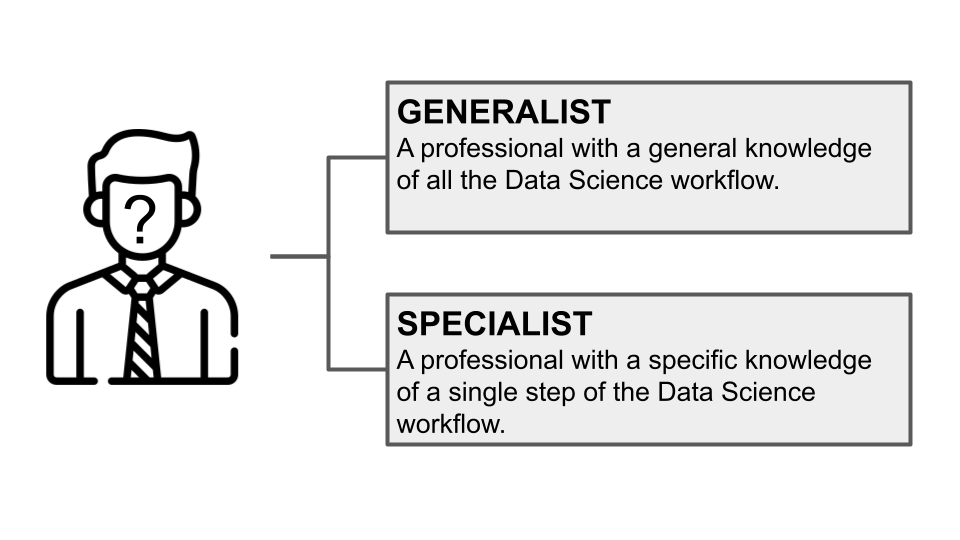
Working as a data scientist is one of the most in-demand jobs today. Companies are looking for data scientists to help them make better decisions, drive growth, and improve operational efficiency. But building a data science team from scratch can be a challenge. In this article, we’ll explore some tips on how to build an effective data science team.
The article is organized as follows:
- How to start building a data science team
- Specialists vs generalists
- Who to hire first
- What is a strong product team
- Motivating team to write articles and contribute to open source
- Picking the next projects to work on
How to start building a data science team
There are two ways to start building a data team, as shown in the following figure:

-
Defining a project and then starting recruiting — In this case, you should start with the following questions: What problems are you trying to solve? What kind of data do you need to build your project? Answering these questions will help you determine the skillsets and expertise you need on your team. Once you have an idea of the team you need, it’s time to start recruiting.
-
Starting immediately hiring and then defining a project — In this case, you start the recruiting campaign, and then define the project.
Indeed, there is no solution better than the other. In fact, some companies firstly define the project and then start hiring, and other companies that do exactly the opposite. A good trade-off could be a combination of both, in the sense that you could start from a vision, which defines what the end goal should be, but the final product is still unclear.
Although you could have in your mind your final goal, you may not know which features will lead to the final product. For this reason, you could start hiring different roles that would take you to that point to get a better understanding of your vision.
The best way to find talented data scientists is through referrals from people you trust. Attend meetups and conferences related to data science and big data, and post job listings on relevant online communities and forums.
Once you have a few candidates, it’s important to evaluate their skillset carefully. In addition to technical ability, you want to make sure they have strong communication skills and are able to work well in a team environment. The best way to assess these skills is through coding challenges and interviews that test both their technical abilities and soft skills.
Building a data team can be a challenge, but it’s definitely doable with careful planning and execution. By keeping these tips in mind, you’ll be well on your way to creating a strong team.
Specialists vs generalists
When you start hiring, you may search for two types of profiles, as shown in the following figure:

-
generalists — professionals who have a general knowledge of all the Data Science workflow, from project setup to project deployment, but they do not have specific knowledge of the single steps of the Data Science workflow.
-
specialists — professionals who have specific knowledge of a single step of the Data Science workflow, but do not know the general Data Science workflow.
If you decide to hire specialists, you’ll need to make sure that each team member is able to work together and share their knowledge. This can be a challenge, but if you have the right mix of people it can lead to a very strong team. The advantage of this approach is that each team member will be an expert in their own area and they’ll be able to bring a lot of knowledge to the table.
If you decide to go with a team of generalists, the advantage of this approach is that everyone will have a good understanding of the whole data science process.
In a startup, you should hire first generalists — people who can do pretty much everything. In fact, when you start, you have no lines of code. There’s nothing, which means you need to do back end, front end, DevOps, and whatever.
Instead, if your company is already stable, probably you need more specialists, who focus on specific problems, such as tuning hyperparameters of a Machine Learning model.
As your company grows, you may begin hiring more and more specialists and fewer generalists.
Who to hire first
When building a data science team, it can be difficult to decide who to hire first. The answer, of course, depends on your specific needs.
But in general, we recommend hiring first the following three profiles, as shown in the following figure:

-
Machine Learning engineers or Software engineers with Machine Learning skills.
-
Data engineers, that build and maintain the systems that collect and store all that data.
-
Product managers, that prioritize the work to do.
At the beginning, you need people who can work on the prototype, who will write a lot of coding, and who will work on the product. It doesn’t make sense for you to hire a UX/UI designer when you have no work for them.
Of course, every team is different, and you may find that you need to hire a different combination of roles depending on your unique circumstances. So you really need to understand, at which stage you are. And what kind of roles do you need now to solve this problem.
What is a strong product team
To build a strong product team, it is important to first understand what a product team is. A product team is responsible for the development and management of a company’s products. This includes everything from the initial idea and conception of the product, to its design, production, and eventual distribution.
A strong product team is a team that is building a product that the customer wants. Strong means:
-
Very customer-centric
-
Delivering features very fast
-
Testing these things out with customers very fast.

In other words, a strong product team will have a clear understanding of the market they are targeting and will work together to ensure that the final product meets the needs of their target audience. In order to build a strong product team, it is important to have a clear vision for the product and to assemble a team of individuals with the skills and experience necessary to bring that vision to fruition.
Motivating team to write articles and contribute to open source
Data science is a collaborative field, and one of the best ways to learn and improve your skills is to share your knowledge with others. Writing blog posts and articles is a great way to do this, and it can also be a good motivator for your team.
You should encourage your team members to write articles about their work and provide them with any resources they need to get started. You can also offer incentives for writing articles, such as bonus points or rewards.
Contributing to open-source projects is another great way for your team to learn and improve their skills. You could even encourage your team members to find projects they’re interested in and contribute their time and expertise. Again, you can offer incentives for open source contributions, such as bonus points or rewards.
Hiring a data scientist
When it comes to building a data science team, one of the most important things to consider is hiring a data scientist. While there are many different ways to go about this, there are a few key things to keep in mind.
First, it’s important to find someone with the right skillset. You can look at the candidate curriculum. A data scientist should be able to not only analyze data, but also understand how to use that data to solve real-world problems. Additionally, they should be well-versed in statistics and modeling, and be able to communicate their findings effectively.
Once you’ve found a few candidates with the right skillset, it’s important to interview them thoroughly. In addition to questions about their experience and qualifications, be sure to ask them about their approach to data science and how they would go about solving a specific problem. This will help you get a better sense of their thought process and whether or not they would be a good fit for your team.
The interview should also include questions on personal experiences, to check whether that person is interesting or not. If someone is just plain boring, this is very difficult for the team. That person also needs a hobby, such as going to the cinema, doing some sports, or whatever. But that person needs to do something. You work more time with that person than you spend with your girlfriend or your wife. You spend more time with them than with the person that you love. So that’s why you need to understand that person really well.
You could also include a second interview, which could be a homework assignment. You could send out some homework, which is not very difficult. Then the candidate sends you the code, whether it is Jupyter Notebook or whatever. Then you should check it. From this simple task, you could already see how much people are working.

Picking the next projects to work on
There are a lot of data science projects out there, and it can be tough to decide which ones to tackle next. Here are a few things to keep in mind when choosing projects:
- Consider the impact of the project. Will it make a big difference for your company or customers?
- Think about the difficulty of the project. Is it something you and your team are confident you can handle?
- Take into account the resources you have available. Do you have the time and budget to dedicate to this project?
- Lastly, don’t forget to have some fun! Data science is supposed to be enjoyable, so pick projects that seem interesting and exciting to you and your team.
Summary
Congratulations! You have just learned some tips on how to build a data science team!
Data science is a rapidly growing field, and it can be difficult to build an effective data science team. However, by following the advice in this article, you can create a team that is well-equipped to tackle your data science projects.
When building a data science team, it is important to consider the skills and experience of each team member. The team should have a mix of technical and non-technical skills, as well as a variety of domain expertise. In addition, the team should be able to work together collaboratively to solve complex problems.
Once you have assembled your team, you need to provide them with the resources they need to be successful. This includes access to data, computing power, and software tools. In addition, you need to create an environment that encourages creativity and collaboration.
By following these tips, you can build a data science team that is poised for success!
Happy Data Science!
The content of this article has been inspired by the podcast episode Building a Data Science Team with Dat Tran at DataTalks.Club.